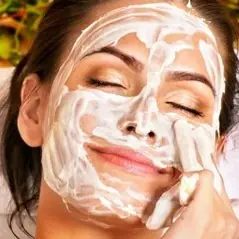Peeling with lactic acid will help rejuvenate and refresh your facial skin without damaging it. It acts so gently that it can be used even on very sensitive skin when other products are not suitable.
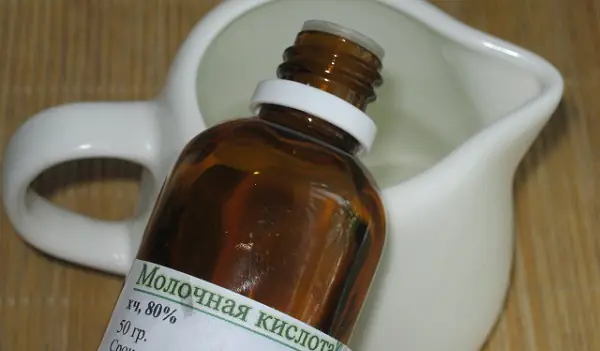
Operating principle of milk peeling
Lactic acid affects the top layer of the skin - the epidermis. At the same time, dead skin cells are exfoliated, collagen and elastin are actively produced - substances on which its elasticity and tone depend.
You can feel the changes immediately, but the peeling will have to be repeated for a visible effect. 3-5 times with a break of 10-15 days.
How to make milk peeling
For peeling with lactic acid at home you will need:
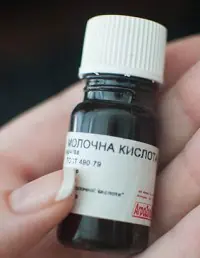
Lactic acid solution (from 30 to 70%, can be purchased at the pharmacy) - for the first time, choose the lowest percentage or be sure to dilute with water (otherwise a burn may occur). It is recommended to first make a 5% solution - this is approximately half 1 pipette of product for 16 whole pipettes of water.- Regular cotton pads
- Medical alcohol,
- Hair dryer (optional).
Stages of the procedure:
Start with preparation. Wash your face with water and cleanser, pat your face dry with a towel. Then degrease the skin: use a cotton pad soaked in alcohol to wipe your face, starting from the forehead and moving to the neck. Apply the solution generously lactic acid on a cotton pad, but do not overdo it so that the product does not drip. Apply to the face, also starting from the top, trying not to get it on the skin in the area of the lips and eyes. You can protect these areas with Vaseline or a thick cream. Note the time. The duration of the first procedure is no more than 1-2 minutes. If you experience burning or tingling sensations, use a hairdryer - simply direct a stream of cool air onto your face, this will help reduce discomfort. However, if the burning becomes unbearable, the procedure should be stopped to avoid chemical burns. Wash your face with cool water over time (warm or hot water can cause severe redness and irritation). You can apply the moisturizer that you are used to using.Video instruction
When performing repeated procedures, listen to your feelings. If you feel accustomed to the product, you can increase the concentration of lactic acid and the peeling time.
A very simple option for peeling with lactic acid at home - using masks with products containing lactic acid (kefir, sour cream, cottage cheese, whey).
You can wash your face with milk in the morning.
Recipe for a curd mask - find out.
Face mask with sour cream - recipe.
With prolonged use, these manipulations will also give a good effect.
Indications
The procedure is suitable for you if you have the following facial skin problems:
- High sensitivity or allergy to other types of chemical peels,
- There is acne, black spots on the face, increased sebum secretion,
- There is hyperpigmentation, freckles,
- Expression wrinkles appear, elasticity is lost,
- Unhealthy, dull complexion.
Before and After the procedure - photos
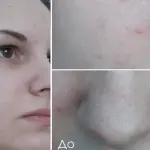
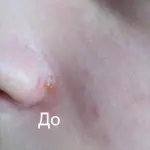
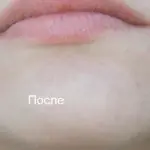

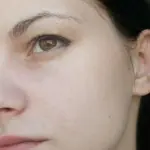
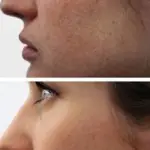
Who can't?
Contraindications to peeling with lactic acid include:
- Oncological diseases,
- Pregnancy and lactation period,
- Diabetes,
- Skin diseases,
- Open wounds, ulcers, pustules,
- The period of exacerbation of herpes.
We recommend reading:
Find out the recipe for Victoria Boni's secret peeling: photos and videos.
7 magical properties of almond peeling - more details.
Premium brand mousse for milk peeling
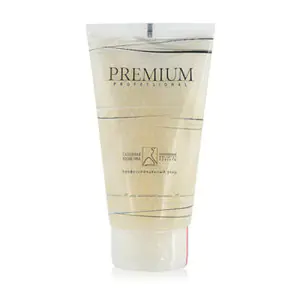
To carry out peeling at home, you can use compositions for professional care, for example, “Milk Mousse” peeling with lactic acid from the Russian brand Premium.
The mousse has a pleasant aroma and soft texture and is especially gentle on the skin. Unlike a pharmaceutical solution, you need to apply the mousse for 10 minutes.
As a result of the procedure, the complexion looks whiter and more even, the skin becomes fresh and moisturized.
When used once a week, the product lasts for more than a year, which fully justifies its cost.
Reviews
Marina: I did milk facial peeling in the salon - after a course of procedures, my problematic skin was unrecognizable, acne completely disappeared, it became lighter and younger, completely renewed.
Christina: It didn’t work for me, the acne didn’t go away, only irritation appeared. Perhaps I mixed the ingredients incorrectly, because... I did it myself. They say you have to dilute it, but I didn’t. So be careful.
Julia: I like to make a kefir mask a couple of times a month with the addition of 1 drop of lactic acid from the pharmacy, leave it on for 5 minutes and wash it off. My face is always clean and fresh, I recommend it.
Greetings, my dear friends. Agree that there is now quite a wide choice of peelings - from deep chemical peels to delicate superficial ones. If you are not a fan of aggressive cleansing procedures, milk facial peeling is perfect for you. I’ll tell you how to make it yourself at home in this article.
What it is
Lactate or lactic acid is an organic acid. This substance is formed during the breakdown of glucose. It is present in pickles, curdled milk, wine, natural kvass and ripened cheese. But this does not mean at all that you need to rub yourself with pickles 🙂 For aesthetic medicine, lactate is released using an enzymatic reaction.
Lactanoic acid has a small molecule. It easily passes through the membrane of epidermal cells. Therefore, it provides the same effect on all areas of the skin.
Lactic acid has excellent effects on the skin:
- Helps lighten skin by influencing melanin production. Due to excessive production of this substance, age spots appear on the skin. Peeling helps neutralize these consequences.
- Enhances natural production of elastin and collagen. As a result, wrinkles are smoothed out and skin turgor increases.
- Provides anti-inflammatory effect. This is achieved due to the fact that lactate acidifies the skin.
- Antioxidant effect - acid helps reduce the aggressive effects of harmful factors (for example, ultraviolet radiation) on the skin.
- Keratolytic effect - achieved by exfoliating keratinized cells.
- Provides intense skin hydration.
The effectiveness of lactic acid peeling depends on the correct procedure technique. Cosmetologists work with a higher content of active substance. But it is also more dangerous in terms of side effects when used independently. For home use, products with a concentration of 10-15% are quite suitable.
What skin is it suitable for?
The main advantage of milk peeling is its versatility. It can be used for all skin types (sensitive is no exception). Indications for exfoliation:
- dehydration of the skin, its pallor and dullness;
- increased skin dryness, peeling;
- photoaging;
- acne;
- the presence of freckles and age spots;
- decreased skin elasticity, wrinkles, etc.
In addition, exfoliation is recommended to be carried out before performing complex salon cosmetic procedures - for example, laser resurfacing of post-acne. As you can see, milk peeling has a considerable range of purposes.
ARTICLES ON THE TOPIC:
How cosmetologists perform milk peeling
Peeling with lactate can be done in a beauty salon. Professional cosmetologists work here who will perform the procedure in the best possible way. It is advisable not to sunbathe 2 weeks before the procedure. And even in cloudy weather, you should use sunscreen cosmetic products.
Exfoliation in a beauty salon does not take much time. On average, the procedure lasts up to 45 minutes
Before starting peeling, the cosmetologist will carefully analyze the condition of the skin. And he will give recommendations on what to do after the procedure at home. For peeling, 30–80% lactic acid is used. The concentration of the active substance is selected by the cosmetologist taking into account the type and color of the skin.
Here are the photos before and after the procedure:
Protocol in cosmetology
- Cleanses the skin of cosmetic residues and dirt. For this purpose, special makeup remover gels and lotions are used.
- Afterwards, toning and degreasing are carried out. A lotion that contains fruit acids helps to achieve this effect.
- Pre-peeling procedure - used to determine the sensitivity of the skin to lactic acid. If pre-peeling is not performed, exfoliation is carried out with a minimum concentration of lactate. Only after making sure that there is no adverse reaction, the cosmetologist begins to carry out a full procedure.
- The peeling procedure itself. The drug is applied to the face, neck, and décolleté using a special brush. And leave for a certain time (from 3 to 20 minutes). The duration of exposure to lactate is individual in each case. All this time, the cosmetologist monitors the skin’s reaction.
- Next, the drug is washed off with cold water. The use of hot water at this stage is prohibited! It can react with lactate and cause skin irritation. After washing, the epidermis is dried.
- Neutralization is in progress. A composition with a neutralizing effect is applied to the entire area where exfoliation was performed.
- At the final stage of the procedure, masks are applied depending on the skin type, for example, alginate. Afterwards a nourishing cream is applied.
I picked up a video where a cosmetologist exfoliates with lactic acid. The master comments in detail on his actions, paying attention to what he is doing and why. She also gives recommendations on the drugs used, describing their composition and effect.
How often can this be done and the cost of the procedure?
The result after exfoliation (based on what the reviews say) lasts for six months. However, one procedure is not enough, although the effect will already be visible after it.
Cosmetologists recommend taking a full course of peeling every year. These are 3-6 procedures, between each of which there should be a break of 10-14 days
How much a full course of exfoliation will cost you depends on several factors. Firstly, this is the price of the drug used during the procedure. It may vary depending on the brand of cosmetic product. Secondly, the cost is influenced by the qualifications of the cosmetologist who performs this procedure. It’s better not to save money here, but to immediately contact a good specialist with experience. Naturally, this will cost more.
On average, the price of one procedure is 3,000 rubles. If this cost is too expensive, then look at the promotions on Biglion or Groupon. Very attractive offers often appear there.
Post-peeling care
The most important thing to do at home after cosmetic procedures is to take care of your skin. At first after the procedure, itching and pain may occur. These are completely normal phenomena - there are no pathologies or abnormalities here. But you shouldn't tolerate them. Hydrocortisone or fireweed extract will help relieve itching. You can cope with painful sensations with the help of ibuprofen or arnica extract.
And regular post-peeling care is required. It includes 3 stages, which are described in detail below.
Cleansing – cosmetic milk with antibacterial components will do for these purposes. These include orange oil, citric acid, green tea, etc. When the skin begins to peel, use products with small abrasive particles to care for it. They provide a light cleansing effect. The name of such products contains the word polish.
Recovery – ideal cosmetic compositions with panthenol, vitamin E and omega acids. Skin care products containing arbutin, cucumber or grapefruit extract will help prevent hyperpigmentation. Never use cosmetics with a high content of mineral oils and dimethicone silicones. They will increase skin temperature and create an ideal microclimate for bacteria to multiply.
Protection – cosmetic products with SPF protection of at least 20 will help with this. Cosmetologists also advise choosing skin care products that contain physical filters. For example, it could be zinc oxide or titanium dioxide. It will provide both UV protection and antimicrobial support.
DIY peeling at home
Nowadays, most professional products are available for free sale. On the one hand, this is good, on the other hand, the ingredients are potent. We are not taught how to use them. And we turn to the Internet for help, and then “make it” in our kitchen.
At first, I found the option of making my own peeling. Probably there is a “devil” in everyone who says: “This is a cheap product, worth a penny! Look how girls talk about him. Let's run to the pharmacy and get it done" Only later does it become clear that you have to pay for everything. Not with your wallet, but with your health.
I'll tell you about a cheap peeling recipe at home and why I don't recommend it. This is the use of lactic acid at a concentration of 80%. This is a very large percentage, which even cosmetologists do not always use. At home it is diluted with ordinary water. The percentage varies for everyone - 1:13 or 1:3. After dilution, wipe the product over the face with a cotton swab or disk for about 5-7 minutes. Then they wash their face and apply their favorite cream. And again - instantly rejuvenated 🙂
On YouTube I found only 3 reviews from girls who tried this product. Here's one of them.
This reminds me of our grandmothers’ recipe, when there was nothing and at least spread something. Dear girls, approach everything wisely. I would rather use professional cosmetics with well-chosen ingredients. In it, I am at least sure that the allergic reaction is minimized and I will not get any side effects. Yes, cosmetics are more expensive. Although no, skin restoration after homemade handmade products costs even more.
Which peeling to buy for use at home
I spent a long time selecting funds. I thought I would tell you about different manufacturers. But for now I liked the line from the brands BEAUTYMED and GIGI. These products are used by professional cosmetologists. The GIGI line includes products for skin preparation, peelings themselves with an acid concentration of 10-30% and post-care products.
Even at home, you need to follow the procedure protocol:
- Before performing the procedure, cleanse the skin using a special emulsion;
- Apply the exfoliation product to clean, dry skin, avoiding the eyelid area. This must be done with gloves. Leave for up to 5 minutes;
- then wash your face with cool water. Next, blot the epidermis and treat it with a neutralizing tonic;
- apply moisturizer.
Be extremely careful when performing this procedure. Avoid getting the drug in your eyes. If you suddenly experience a strong burning sensation during exfoliation, immediately wash your face with cool water. If the irritation does not go away within a couple of days, be sure to consult a dermatologist. Plus, a week before and during the procedure, exclude products with retinol from your care. This will prevent an increase in skin photosensitivity.
To begin with, I selected for you products with a 10% concentration of acids. For beginners this is an ideal option.
Peel Therapy Glycolic Acid Complex – this product is from the company BEAUTYMED (France). This is a 10% peeling with a healing complex. It contains: malic, lactic, tartaric, glycolic, citric and hyaluronic acids. In addition, there are extracts of blueberry, grape leaf and sugar cane. Arginine RSA is also added to the composition. Acidity level - pH 3.
This combination of ingredients is perfect for normal, pigmented and very dry skin. Exfoliates gently and renews the epidermis. The drug is sold in a 50 ml bottle. Judging by the reviews, it lasts a long time.
Peel Therapy Salicylic Acid Complex - This is already a remedy for problematic, oily and acne-prone skin. The drug has a 10% acid concentration.
The composition contains 6 acids: citric, grape, salicylic, lactic, malic and hyaluronic. The drug helps soften and regenerate the skin. And thanks to the presence of salicylic acid, it reduces pores and normalizes the oiliness of the epidermis.
The product is sold in frosted glass containers. Volume – 50 ml. The drug has a transparent thick consistency.
Neutralizer GLYCOPURE – it contains propylene glycol, hydroxyethylcellulose, triethanolamine and water. This is an alkaline transparent solution that can be used on any skin. Bottle volume 250 ml.
Side effects and contraindications
As I already said, itching and pain may occur after peeling. But these problems are solvable. If you can't deal with them on your own, consult a dermatologist.
Although exfoliation with lactate is considered an extremely gentle procedure, it also has contraindications:
- allergic reaction to the components of the drug used;
- pregnancy and lactation;
- herpes;
- cancer;
- diabetes;
- taking antibiotics;
- rosacea;
- elevated body temperature, etc.
Although this peeling can be performed in the summer, it is still undesirable. The sun's rays are very active during this period. Therefore, cosmetologists recommend this procedure be carried out either in autumn or winter.
My friends, have you ever done milk peeling? If yes, please describe your impression. And if you have a photo, attach it to the comment. Yes, and don’t forget to subscribe for updates. And that’s all I have for today: bye-bye.
If you regularly exfoliate with lactic acid at home, your skin will lose many imperfections, become younger and gain a radiant, healthy color. The secret of the acid is that, without injuring the skin, it penetrates to the depths of the epidermis and cleanses it of keratinized particles, fat and other contaminants. In parallel with cleansing, the product moisturizes and nourishes the epidermis, increasing its tone and elasticity. As a result, you look young and fresh.
The principle of action and effectiveness of peeling with lactic acid
Peeling with lactic acid is a gentle way to renew the skin due to a chemical effect on it and accelerating regeneration. The described exfoliation refers to gentle, non-traumatic methods of exfoliation of the skin. The procedure is simple, so it can be done at home. The correct choice of concentration of the main product allows you to achieve optimal results. An exfoliant is lactic acid, which belongs to the class of alpha acids and produces a number of beneficial effects on the skin:
- Stimulation of collagen production;
- Regulating the functions of the sebaceous glands;
- Regulating the pH of the skin;
- Fights blackheads and acne;
- Provides increased elasticity;
- Creates a rejuvenation effect;
- Smoothes wrinkles;
- Produces cleansing, whitening, brightening and tightening;
- Fights microbes and inflammatory processes.
Lactic acid is found in yoghurt, cottage cheese, sour cream, and yogurt. Many women like to make masks from these products. Their effectiveness and ability to prolong youth is not an empty advertising sound, but a time-tested fact. Concentrated lactic acid acts more radically and has an even more rejuvenating effect on the skin.
Milk peeling at home quickly leads to the following effect:
- Oily shine goes away;
- Skin redness and inflammation disappear;
- Wrinkles are smoothed out;
- The relief of the face becomes smoother and clearer;
- Acne spots disappear;
- Pigmentation is eliminated;
- The skin becomes fresh, radiant, rejuvenated.
Exfoliation is not intended to eliminate deep wrinkles, stretch marks and scars. To eliminate serious deficiencies, you need to contact professional cosmetologists at the salon.
Did you know that the word “peeling” comes from the English “peel”, which translates as “scrape” or “sand”.
Are there any contraindications and side effects?
Any procedure, even the most harmless one, has contraindications. Milk peeling for the face is considered safe, so it can be done at home. However, even in this case, there are a small number of factors, the presence of which, the manipulation should be abandoned. This:
- Minor age;
- Lactation;
- Pregnancy;
- Malignant neoplasms on the skin;
- Tendency to form scar tissue;
- Recent depilation, solarium, tanning procedures;
- Spider veins on the face;
- Excessively sensitive skin;
- Presence of pigmented nevus;
- Individual intolerance to exfoliant;
- Aggravated herpes;
- Inflammatory processes on the face, purulent and other wounds.
You should be especially careful with chemical peels with high concentrations of lactic acid. This procedure should be carried out in a salon under the supervision of an experienced cosmetologist.
Even with a low concentration of exfoliant, it is necessary to strictly follow the instructions and not overexpose the active substance on the face and other parts of the body. With any peeling you need to know when to stop.
Rules for peeling from a cosmetologist
Facial peeling with lactic acid at home is carried out similarly to a cosmetic procedure. The manipulation is done in several stages:
- Sensitivity test.
- Preparation.
- Cleansing.
- Direct exfoliation.
- Completion of the procedure.
The manipulation doesn't end there. For several days after it, the skin requires special attention and special care.
The precursor to everything should be a test. It should be done the day before exfoliation to determine the reaction to the exfoliant. Testing is carried out on the wrist, where a weakly concentrated solution of the active substance is applied. If there are no reactions in the form of itching and redness, the procedure can be carried out.
Cosmetologists recommend avoiding visiting beaches and solariums approximately 2 weeks before the procedure. Do not use sunscreen. If you notice herpetic rashes, start taking antiviral medications. In order for the skin to get used to lactic acid, use creams containing an exfoliant at the preparatory stage.
Before treating your face with the active substance, cleanse the skin of fatty contaminants and cosmetic residues. To do this, use your usual cleansers. Then carry out degreasing. The best remedy would be a tonic containing fruit acids. If you don't have it, you can use alcohol. It is necessary to treat the face without affecting the nasolabial area and under the eyes. It is better to lubricate these places with Vaseline.
Direct treatment involves applying an exfoliant solution of varying concentrations to the face. Before doing milk peeling, decide for yourself how much time you will spend on the procedure. If you are doing it for the first time, if your skin is dry, it is better to keep the product on for no more than half a minute. Already during the next manipulations, increase the time by 30 seconds.
It is best to apply the product with a brush, but cotton pads will also work. Make sure that the drug does not spread. Avoid contact with mucous membranes. Start applying from the forehead and then massage down to the chin. If you feel a burning sensation, direct a stream of cool air onto your face. To do this, prepare a hairdryer in advance.
Immediately after the prescribed time has expired, rinse off the product with plenty of cool water. Next, apply a moisturizing mask to the treatment area. It should be kept for at least 15 minutes and then rinsed off with cool water. The final touch is the application of a nourishing cream, preferably containing aloe oil.
As noted earlier, for a few more days your facial skin will need your increased attention.
Milk peeling recipes at home
Before doing lactic acid peeling at home, choose the most suitable recipe for yourself. Let's give an example with a weakly concentrated exfoliant, only 4%. 10 gr. The drug must contain:
- Lactic acid – 0.5 g;
- Water, preferably distilled – 9.5 g.
Before you make a lactic acid peel, which you will use at home, take care of a product that neutralizes the acid. The neutralizer will provide safe and painless exfoliation. An effective product is made from:
- 1 teaspoon of soda;
- 1 cup distilled water.
It is important to prepare the exfoliant itself correctly: you should always add the active substance to the water, and not vice versa. This is the only way you will get high-quality milk peeling at home, which acts as an effective scrub.
The concentration shown is suitable for initial procedures, when the skin is not yet accustomed to the exfoliant and may react negatively to it. The optimal concentration for home use is 25%. The toughest and most painful option is 80%.
Milk peeling for the face from fermented milk products at home can have an extremely low concentration. As already noted, both sour milk and sour cream will have a cleansing effect. These products are good for women and girls. At any age, they will treat and rejuvenate the skin, saturating it with necessary substances.
For light peeling you can use the following recipe:
- 1 tablespoon of fat sour cream;
- 1 yolk;
- 1 teaspoon chopped oatmeal;
- 1 teaspoon lemon juice.
First, the yolk and oatmeal are mixed, then the remaining ingredients are stirred until smooth. The product is applied for 3 minutes with massaging movements and then washed off.
Cosmetologists recommend carrying out the procedure once a week. The effect will be visible after approximately 8-10 procedures for those with oily skin and after 4-5 procedures for those with combination and normal skin.
This is interesting: the first professional peelings were used back in XIX century in Germany. Cosmetologists of the century before last used resorcinol and salicylic acid.
How to care for your skin after procedures
After milk peeling, you need to completely stop using creams that contain fruit acids and retinoids for several days. For 2 days you should not touch the skin of your face.
In the following days, you should treat your face with moisturizers. For the first 10 days, try to avoid direct sunlight on the treated areas.
For many women, the important question is whether the skin will peel off. The answer to this can be either positive or negative. The final effect depends on the concentration you choose and the properties of the skin: dry skin will give up faster, oily skin will last a little longer.
Summary
Milk peeling at home can be made from fermented milk products - the most gentle method, or lactic acid. The initial concentration should be minimal to allow the skin reaction to be determined. Then you can increase the percentage of distilled water and exfoliant. Gradually, you will determine the optimal concentration for individual use and will be able to provide your skin with regular cleansing and care.



